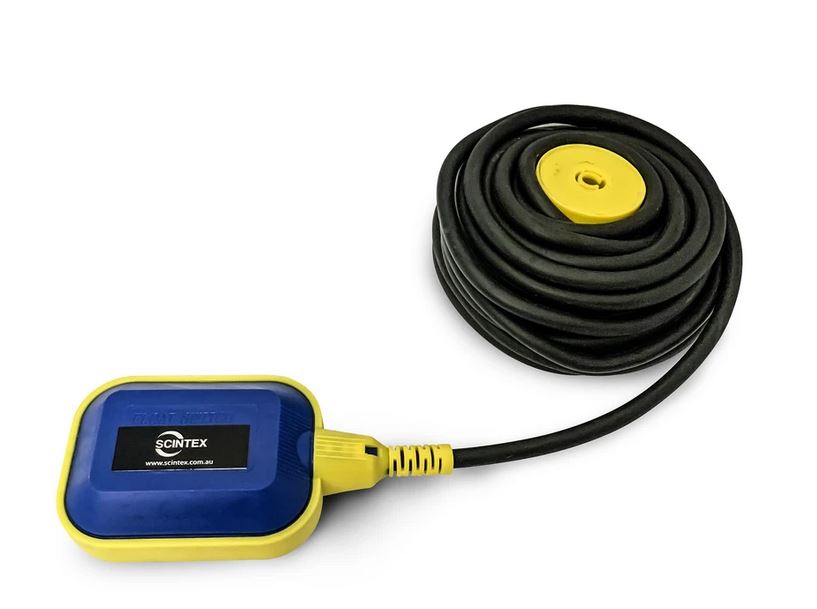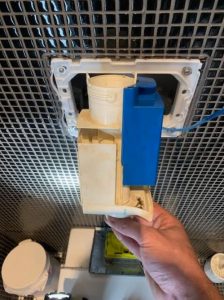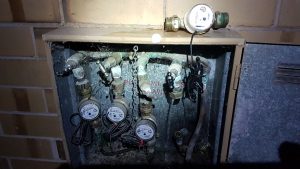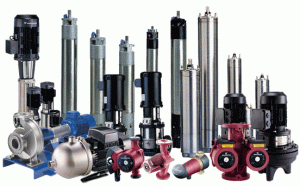A pump used for transferring liquids from a holding chamber will often be turned on and off by a primary float switch installed inside the pit. In some of the simpler installations there may only be one float valve which engages the pump to turn on and off. In more complex set ups for commercial and industrial installations there can be many float switches installed operating numerous pumps and different tasks inside the pumping station.

How The Float Switch Works
A float switch is typically housed inside a sealed plastic case (like in the image on this page) which has a small ball inside of it. When the float rises with the liquid level (sewer or storm water) it will move up (float) and cause the pump to engage, as the liquid level drops the ball inside the case will drop and tell the pump to stop. These float switches are adjustable in heights to suit the various uses and demands.
In some cases of small use our plumbing technicians at Mayfair Plumbing might adjust the levels to operate more frequently to allow the liquids to be transferred out of the holding tank and not cause algae, smells and bacteria build ups.
In situations of high use, we don’t want the pump to be short cycling so our pump plumbers will allow to chamber to fill up quite high and then drain itself to the minimum levels, this ensures the pump will not continually be running and have time to cool down prior to cycling again once the sump is filled again.
What Different Floats Perform Inside A Pumping Chamber?
As we previously touched on in the paragraph before the primary float will turn the pump on and off as the liquid levels raise and drop inside of the pumping station.
If there are two pumps installed there will be two primary floats, one for each pump. The control station will operate each pump alternatively to ensure equal load placed upon each pump allowing for fare wear and tear. In majority of the commercial sewer pumps and storm water pumping stations there will be an alarm installed. The high-level alarm is used to alert the user of a malfunction with the pump system. There is a flashing light installed in a location which often frequented such as a reception area or main entrance location.
The high-level float will activate when the liquid level gets too high a pump or multiple pumps fail. There is a delay on the pump high level alarm of approximately 20 minutes. The delay is designed to allow for high volumes of liquid entering the chamber which may occasionally cause the pumps to delay a little on removing the water or sewer from the pumping station.
Regular Inspections And Maintenance
Like most things inside a pump station, they are out of site and out of mind. A pump needs regular maintenance especially in commercial applications to avoid pump failure, Mayfair Plumbing are pump experts across all of Adelaide and the Adelaide Hills in South Australia.
Float switches are connected to electrical cables which transfer the information from the pumping chamber to the above ground control box, the control box then tells the pumps what to do. Over time these cables can harden over time and stop flexing with the movement of the liquids inside the pump stations. When this happens, it can give false alerts to user such as high-level alarm and pump motor burn out due to the pump not turning off and running the motor dry.
Make A Booking
Are you experiencing pump difficulties? Contact us today at Mayfair Plumbing on 0429361819 or via email on plumbers@mayfairplumbing.com.au we are well known in the plumbing industry of Adelaide for all types of pump repairs and installations including all the major brands such as Grundfos, Davey, Lowara, Reefe, Water Pro, Bianco and Onga. We also offer emergency pump repairs after hours for when your pump plays up and you need it fixed fast.





